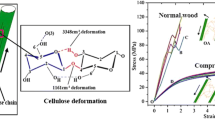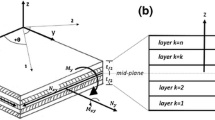Abstract
The deformation of wood is analyzed using the finite element method to quantify the phenomena in wood cells and cell walls. The deformation curves of computed microstructures are compared to experimental observations in two different loading cases: compression and combination of shear and compression. Simulated and experimental shapes of deformation curves match qualitatively and the deformation shapes exhibit a similar response to change in the loading mode. We quantify the intra-cell-wall stresses to understand the effects of the different layers during the deformation. The results benefit the development of energy efficient mechanical and chemo-mechanical pulping processes for pulp, board, and composite manufacture. In addition, the aspects of cell deformation can be exploited to dismantle the wood to accelerate chemical reactions in biorefinery.














Similar content being viewed by others
References
Modén CS, Berglund LA (2008) Elastic deformation mechanisms of softwood in radial tension: cell wall bending or stretching? Holzforschung 62:562–568
Gibson LJ, Ashby MF (1997) Cellular solids: structure and properties. Cambridge University Press, Cambridge
Kollmann FFP, Côté WA Jr (1968) Principles of wood science and technology. Springer- Verlag, Heidelberg
Mishnaevsky L Jr, Qing H (2008) Micromechanical modelling of mechanical behaviour and strength of wood: state-of-the-art review. Comput Mater Sci 44:363–370
Qing H, Mishnaevsky L Jr (2010) 3D multiscale micromechanical model of wood: From annual rings to microfibrils. Int J Solids Struct 47:1253–1267
Barnett JR, Bonham VA (2004) Cellulose microfibril angle in the cell wall of wood fibres. Biol Rev 79:461–472
Konnerth J, Buksnowitz C, Gindl W, Hofstetter K, Jäger A (2010) Full set of elastic constants of spruce wood cell walls determined by nanoindentation. In: Proceedings of the International Convention of Society of Wood Science and Technology and United Nations Economic Commission for Europe – Timber Committee October 11–14, 2010, Geneva, Switzerland
Dvinskikh SV, Henriksson M, Mendicino AL, Fortino S, Toratti T (2011) NMR imaging study and multi-Fickian numerical simulation of the moisture transfer in Norway spruce samples. Eng Struct 33:3079–3086
Salmén L, Burgert I (2009) Cell wall features with regard to mechanical performance. A review COST Action E35 2004-2008: wood machining: micromechanics and fracture. Holzforschung 63(2):121–129
Hofstetter K, Gamstedt E (2009) Hierarchical modelling of microstructural effects on mechanical properties of wood: a review. Holzforschung 63:130–138
Eitelberger J, Hofstetter K (2010) Multiscale homogenization of wood transport properties: diffusion coefficients for steady-state moisture transport. Wood Mat Sci Eng 5(2):97–103
De Magistris F, Salmén L (2005) Deformation of wet wood under combined shear and compression. Wood Sci Technol 39:460–471
De Magistris F, Salmén L (2006) Mechanical behaviour of wet wood in sequences of compression and combined compression and shear. Nord Pulp Pap Res J 21(2):231–236
De Magistris F, Salmén L (2008) Finite element modelling of wood cell deformation transverse to the fibre axis. Nord Pulp Pap Res J 23(2):240–246
Persson K (2000) Micromechanical modelling of wood and fibre properties, PhD Thesis, Lund University, Department of Mechanics and Materials, Lund, Sweden
Tsai SW, Hahn HT (1980) Introduction to composite materials, In: Technomic pub. Lancaster
Nairn JA (2006) Numerical simulations of transverse compression and densification in wood. Wood Fiber Sci 38(4):576–591
Muzamal M, Gamstedt EK, Rasmuson A (2014) Modeling wood fiber deformation caused by vapour expansion during steam explosion of wood. Wood Sci Technol 48:353–372
Bergander A (2001) Local variability in the chemical and physical properties of spruce wood fibers, PhD Thesis, KTH, Department of Pulp and Paper Chemistry and Technology, Stockholm, Sweden
Thuvander F, Kifetew G, Berglund L (2002) Modelling of cell wall drying stresses in wood. Wood Sci Technol 36(3):241–254
Keunecke D, Sonderegger W, Pereteanu K, Luthi T, Niemz P (2007) Determination of Young’s and shear moduli of common yew and Norway spruce by means of ultrasonic waves. Wood Sci Technol 41:309–327
Salmén L, Fellers C (1982) The fundamentals of energy consumption during viscoelastic and plastic deformation of wood. Pulp Pap Can Trans Tech 4(9):93–99
Abaqus User’s Manual (2013) Version 6.13-2, Dassault Systèmes
Alart P, Barboteu M, Gril J (2004) A numerical modelling of non linear 2D-frictional multicontact problems: application to post-buckling in cellular media. Comput Mech 34:298–309
Masters IG, Evans KE (1997) Models for the elastic deformation of honeycombs. Compos Struct 35:403–422
Krauss A, Molinski W, Kúdela J, Cunderlík I (2011) Differences in the mechanical properties of early and late wood within individual annual rings in dominant pine tree (Pinus sylvestris L.). Wood Res 56(1):1–12
Mackenzie-Helnwein P, Müllner H, Eberhardsteiner J, Mang H (2005) Analysis of layered wooden shells using an orthotropic elasto-plastic model for multi-axial loading of clear spruce wood. Comput Methods Appl Mech Eng 194:2661–2685
de Borst K, Jenkel C, Montero C, Colmars J, Gril J, Kaliske M, Eberhardsteiner J (2012) Mechanical characterization of wood: an integrative approach ranging from nanoscale to structure. Comput Struct 89:476–484
Oudjene M, Khelifa M (2009) Elasto-plastic constitutive law for wood behaviour under compressive loadings. Constr Build Mater 23:3359–3366
Acknowledgements
This work was funded by the VTT project IMAGO (“Integrated Material modelling for demAndinG applicatiOns”) and Academy of Finland under the project 138623 WoodMat.
Author information
Authors and Affiliations
Corresponding author
Rights and permissions
About this article
Cite this article
Fortino, S., Hradil, P., Salminen, L.I. et al. A 3D micromechanical study of deformation curves and cell wall stresses in wood under transverse loading. J Mater Sci 50, 482–492 (2015). https://doi.org/10.1007/s10853-014-8608-2
Received:
Accepted:
Published:
Issue Date:
DOI: https://doi.org/10.1007/s10853-014-8608-2




